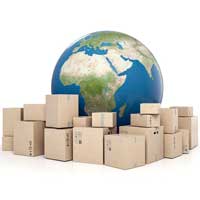Shipping Zones 101: A Brief Guide to International Shipping Zones
 The cost of international shipping depends on many factors, one of which is the distance to the destination country. To make their rates more transparent, postal and courier services divide all countries into several shipping zones and assign different rates to different zones. Let us offer you a brief guide to international shipping zones that will help you plan your shipping costs.
The cost of international shipping depends on many factors, one of which is the distance to the destination country. To make their rates more transparent, postal and courier services divide all countries into several shipping zones and assign different rates to different zones. Let us offer you a brief guide to international shipping zones that will help you plan your shipping costs.
To say that shipping zones depend on the distance from the point of origin to the point of destination is to put it simply. Couriers typically assign shipping zones based on the locations on their warehouses and sorting centers, so physical distance isn’t the only factor that is taken into account when dividing countries into international shipping zones. In addition, the shipping zone of your package may depend on the service you’re using.
How do shipping zones affect international shipping? Two aspects of international shipping that are directly affected by shipping zones are shipping cost and delivery speed. The distance your package has to travel is one of the factors that affect the cost of the shipment, along with the mail class you use and the weight of your package (either gross or dimensional, depending on whichever one is greater).
The time your package spends in transit also depends on the shipping zone and the mail service you use. So, knowing the shipping zone will allow you to find the perfect balance between shipping costs and delivery time.
E-commerce business owners sometimes use shipping zones to reduce their shipping costs and/or delivery time. Instead of shipping directly to the point of destination, they use fulfillment centers located in different shipping zones.
A package that has to pass several zones en route to its final destination is shipped from zone A to zone B, from zone B to zone C, etc., which, surprisingly, may help cut the shipping cost and the transit time because shipping between neighboring zones is quicker and cheaper than direct shipping between two zones that are located far from one another, provided that you have a network of fulfillment centers.
And now, let us take a closer look at how international shipping zones are assigned by major shipping carriers.
USPS International Shipping Zones
The United States Postal Service (USPS) has different country price groups, and one country can belong to different price groups depending on the international mail service you’re using: Global Express Guaranteed, Priority Mail Express International (PMEI), Priority Mail International (PMI), First-Class Mail International (FCMI), or First-Class Package International Service (FCPIS). The country’s price group may also vary depending on whether you’re using flat rate pricing or not.
For example, the United States’ closest neighbor, Canada, belongs to price group 1 regardless of the service you’re using. However, if you need to ship, say, from the United States to Argentina, the price group is 8 if you use Global Express Guaranteed, 10 if you use PMEI or PMI and get charged by weight, 2 if you opt for PMEI or PMI Flat Rate, 9 if you use FCMI, and 11 if you use FCPIS.
You can look up USPS country price groups in the table or use a country price group online tool on the USPS website. You can also use PostageMaker’s shipping calculator to calculate the shipping cost with the country price group already factored in.
UPS and FedEx International Shipping Zones
Unlike the USPS, UPS and FedEx don’t have a country price group table for you to refer to. Instead, they offer to use their online tools to calculate the cost of shipment based on its origin, destination, service, and weight. Please keep in mind that you might also have to pay surcharges such as peak/demand surcharges, fuel surcharges, and extended area surcharges.